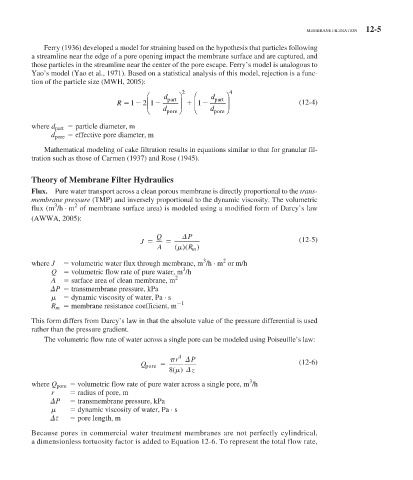Page 488 - Water and wastewater engineering
P. 488
MEMBRANE FILTRATION 12-5
Ferry (1936) developed a model for straining based on the hypothesis that particles following
a streamline near the edge of a pore opening impact the membrane surface and are captured, and
those particles in the streamline near the center of the pore escape. Ferry’s model is analogous to
Yao’s model (Yao et al., 1971). Based on a statistical analysis of this model, rejection is a func-
tion of the particle size (MWH, 2005):
⎛ d ⎞ 2 ⎛ d ⎞ 4 4
⎜
⎜
R 1 2 1 part ⎟ 1 part ⎟ (12-4)
⎝ d pore ⎠ ⎝ d pore ⎠
where d part particle diameter, m
d pore effective pore diameter, m
Mathematical modeling of cake filtration results in equations similar to that for granular fil-
tration such as those of Carmen (1937) and Rose (1945).
Theory of Membrane Filter Hydraulics
Flux. Pure water transport across a clean porous membrane is directly proportional to the trans-
membrane pressure (TMP) and inversely proportional to the dynamic viscosity. The volumetric
3 2
flux (m /h · m of membrane surface area) is modeled using a modified form of Darcy’s law
(AWWA, 2005):
Q P
J (12-5)
A ()( R m )
3
2
where J volumetric water flux through membrane, m /h · m or m/h
3
Q volumetric flow rate of pure water, m /h
2
A surface area of clean membrane, m
P transmembrane pressure, kPa
dynamic viscosity of water, Pa · s
1
R m membrane resistance coefficient, m
This form differs from Darcy’s law in that the absolute value of the pressure differential is used
rather than the pressure gradient.
The volumetric flow rate of water across a single pore can be modeled using Poiseuille’s law:
4 P
Q pore r (12-6)
8( ) z
3
where Q pore volumetric flow rate of pure water across a single pore, m /h
r radius of pore, m
P transmembrane pressure, kPa
dynamic viscosity of water, Pa · s
z pore length, m
Because pores in commercial water treatment membranes are not perfectly cylindrical,
a dimensionless tortuosity factor is added to Equation 12-6 . To represent the total flow rate,

